At London’s Royal College of Art, the fiercely progressive Fashion MA programme goes far beyond the ‘graduate collection’.
Photographs by Oliver Truelove
Videos by Rafa Yuste
Video Interviews by Rahim Attarzadeh
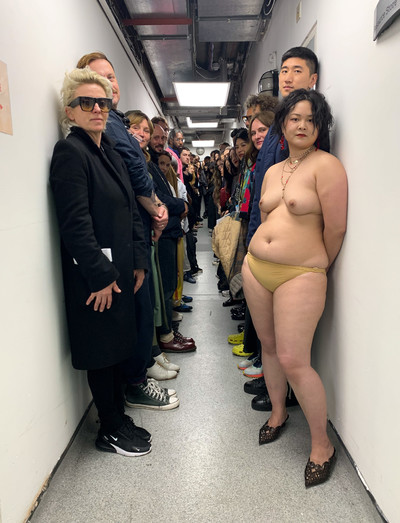
At London’s Royal College of Art, the fiercely progressive Fashion MA programme goes far beyond the ‘graduate collection’. Here, System meets a cohort of the class of 2022.
Maria Nava, 28
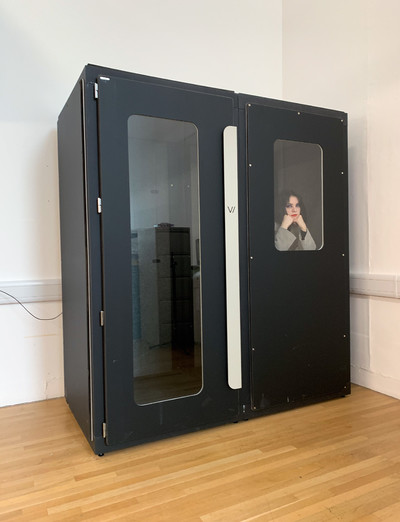
Tell us about your collection.
Maria Nava: Spectral Objects is a provocative piece focused on the romanticized idea of a ghost in science. The project comments on our identities and how we become ourselves. We are more than a passport and the place where we were born. We are also the places where we have lived; we are the people we have met. We are experiences, conversations and interactions. A ghost is an infinite memory, and we are the product of memories.
What were your stylistic ambitions and references? What did you want to communicate through your collection?
Maria Nava: The purpose of this project is not to provide an answer, but to create a unique, interactive world for anyone and everyone to come in and discover the connection between memories and identity. It’s an investigation into how touch triggers motion, which then provokes different emotional behaviours. The skin is the largest organ in the human body and acts as our first point of contact with the outside world. Spectral Objects proposes the idea of skin as a recording machine. How can memories of sound and touch be preserved in a kinetic artefact? How can memories shape the motion of this artefact? What happens when these artefacts interact through touch, not only with our bodies, but also with an external environment?
What’s the best thing about the Royal College of Art’s MA fashion programme?
Maria Nava: The conversations, feedback and problem-solving bounce-back with tutors, heads of programmes, technicians and other students.
Which person in fashion do you most admire, and why?
Maria Nava: More than a single person, I admire designers and artists who constantly challenge pre-established ideals of what fashion can be.
What can younger designers express through fashion that designers from an older generation cannot?
Maria Nava: Digital technology and craftsmanship are not polar opposites. Fashion can exist in several realms and can be so much more than just a wearable-collection artefact. It can have a strong aesthetic and at the same time be intelligent, in terms of both manufacturing methods and performance. It can trigger conversations and modify human behaviour; incorporate smart materials that allow these wearable artefacts to learn from different environments; capture human memories and preserve them in a digital archive. Fashion can be anything we want it to be.
Finally, where do you see yourself professionally in five years’ time?
Maria Nava: I would see myself developing a multidisciplinary studio or start-up focused on costume and character-design projects for theatre, performance and film, which would blend robotics, AI and fashion.
Mo Nan, 25
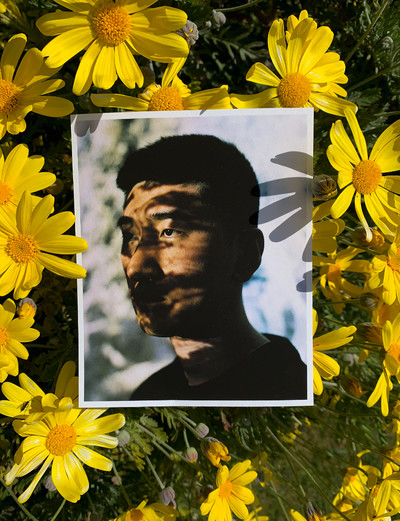
Tell us about your collection.
Mo Nan: My work begins with imagining the future human and the forms that identity will take in the future. I refer to a lot of Donna Haraway’s ideas. We already have cyborgs, with various prostheses acting as extensions of the physical body. For me, the virtual world is another extension of our mind and identity. I started from my fashion background and used masks as a medium to convey my imagination of future identities; then I presented it to the audience in the purely digital form of the game. The future is virtual, but identities are becoming more concrete in it. I want to explore the gap between the digital world and fashion in my future work.
What’s the best thing about the Royal College of Art’s MA fashion programme?
Mo Nan: This place gives me the energy to broaden the boundaries of my own work, and the ability to think critically. My tutor always encourages me to find my own voice in fashion instead of limiting it, and my classmates are so talented; they are constantly updating my definition and view of fashion.
Which person in fashion do you most admire, and why?
Mo Nan: Leigh Bowery. His work and who he was led me to the rift between real world, myth, and identity beyond the constraints of the flesh.
Finally, where do you see yourself professionally in five years’ time?
Mo Nan: I hope I will still be creating how I do now.
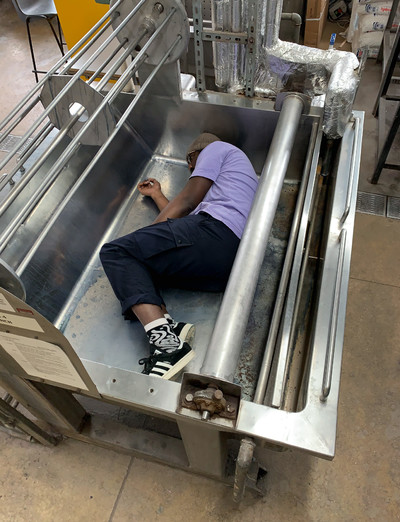
Tell us about your collection.
Reiss Dendie: My design aesthetic explores the idea of craft in shoemaking, led by sustainable methodologies that explore materiality and construction. It’s often informed by advanced technological practices, but that aspect intentionally may not be apparent as I seek to employ crude, domestic interpretations of the systems that inspire me. This approach is influenced by my perceived social class, ethnicity, and lack of access as a pupil within a state-funded educational system. I believe my aesthetic to be performative and esoteric within the context of how my work responds to a lived experience.
The best thing about the Royal College of Art’s MA fashion programme?
Reiss Dendie: The diverse creative community of minds you have the opportunity of meeting and potentially collaborating with, across many disciplines. These constant interactions of sharing ideas and perspective for me can be highly motivating and allow me to focus on achieving what might have felt unimaginable, speculative, or unattainable at one point.
What can younger designers express through fashion that designers from an older generation cannot?
Reiss Dendie: Designers of this modern contemporary time are able to engage with technologies in ways that allow them to respond to a world of both global and domestic concerns. They can challenge social political views to help shape a more progressive humanist world, and are capable of demonstrating and taking the lead in decentralising systems that have failed not only fashion, but also the global manufacturing industry.
Finally, where do you see yourself professionally in five years’ time?
Reiss Dendie: I plan to be in a position where I am capable of providing opportunities or access to resources to the next aspiring creative generation from local and global communities.
Sid Bullmore, 25

Tell us about your collection.
Sid Bullmore: At the RCA I have focused on applying generative design to clothing, relating our anatomy and motion directly to the garments we wear. I wanted to communicate my vision for integrating computational design into clothing to provide a real-world, scalable system to personalize garment design. I believe in the future of the body; its requirements will become part of the design process for many of the products we use. Though my graduate work has focused on clothing, similar technology could be applied to furniture, architecture or food. It’s less about fashion and more about human-centric design: how we collect biometric information and the computational models we use to process that information into better products. It was important to me that the project did not use typical fashion references. The pieces’ appearance was dictated by the simplest, most effective solution to each technical problem. I found balancing these requirements led to a more meaningful aesthetic.
What’s the best thing about the Royal College of Art’s MA fashion programme?
Sid Bullmore: The RCA is the only university that allows students on a fashion MA to push clothing or fashion beyond what might be seen on a runway. There’s such a breadth of interest across our cohort; we can spend a term exploring something completely outside our field and then another term working out how it combines with what we knew before. This has been the best way to grow as a designer over my two years at the RCA.
What can younger designers express through fashion that designers from an older generation cannot?
Sid Bullmore: A key advantage for young designers is that we are more technologically able than older generations. It’s empowering to experience how new digital skills can expand what we are able to design and make.
Finally, where do you see yourself professionally in five years’ time?
Sid Bullmore: I hope that clothing design in the future will be seen as an extension of healthcare and design for well-being. I want to be involved in the development of technology and manufacturing that facilitate this shift. I’m excited by the recent growth of the sportswear industry; it is indicative of peoples’ attitudes to the current fashion industry and what they want or expect from their garments. Working in this area is a good place to start, but I hope over the next five years I can be part of developing products that can be worn less as specific performance pieces and more as material technology that adds real value to our lives.
Shanti Bell, 25
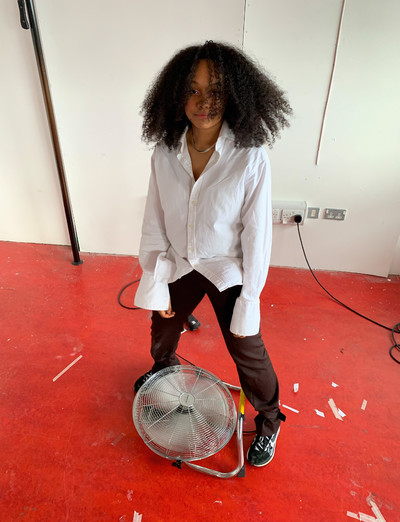
Tell us about your collection.
Shanti Bell: The body of work I am currently creating began when I saw a father teach his son how to fly a kite on a beach. The simplicity of that act made me consider the dynamics of father-and-son relationships within society and my own family, and how the pressures of masculinity can warp and alter this relationship. My work looks to describe visually the emotions felt by the son and express a moment when he is heard through the format of sculpture, set design, sound, performance, and menswear. Visually, the piece will be a balance of minimalism and art, referencing choreography and sound: a sculpture exhibition meets a music jam. Through delicately establishing the effects of an absent father in conjunction with celebrating the free nature of the son, I’m looking to create a moment of conflicting honesty.
What’s the best thing about the Royal College of Art’s MA fashion programme?
Shanti Bell: The RCA not only accepts, but actually welcomes interdisciplinary practices. As a multidisciplinary creative myself, I have found that using other mediums to express ideas is encouraged: entering the wood or metal workshop as a fashion student is greeted with intrigue and excitement as opposed to surprise, which is really great. Also, I find the tutors actively get students to dig deep conceptually to find the authenticity within an idea.
Which person in fashion do you most admire, and why?
Shanti Bell: It is hard to restrict it to simply one person, however, a creative who I have highly admired for many years is Yoann Bourgeois. A dancer, performance artist, and choreographer whose performance pieces have entered the space of fashion, he most recently directed and choreographed the Louis Vuitton Autumn/Winter 2022 show. Bourgeois’ method of engaging the body within set design and his themes of challenging the boundaries of gravity offers a completely fresh and fearless approach to fashion. His work shows how different mediums and forms of creativity can be relevant to fashion, and intertwine and overlap within it.
What can younger designers express through fashion that designers from an older generation cannot?
Shanti Bell: Creatives are not defined by their generation, but by their willingness to be open. New designers approaching fashion within the current social climate have a renewed consideration for the work they produce and its impact. A more conscious approach is being applied where designers are observing and visually commenting on the outside world, which is crucial to creating work that is a reflection of the living. All new designers, myself included, are challenging things that may appear decided and known, and in turn, are offering opportunities for innovation and a shift.
Finally, where do you see yourself professionally in five years’ time?
Shanti Bell: Alongside further learning and expanding my expression in sculpture, set design, performance, furniture and menswear, I would love to be collaborating with creatives from all walks of life and parts of the world, and within different practices. I am interested in creating work that speaks about masculinity from a female perspective, but I’d like to look at how that could be reflected differently by collaborating with others, for example, a glassblower, a group of dancers, or a lighting designer. I always strive to allow the concept to define the creative output so as to ensure authentic expression, and I will endeavour to keep that present within my future work.
Sebastian Röck, 30
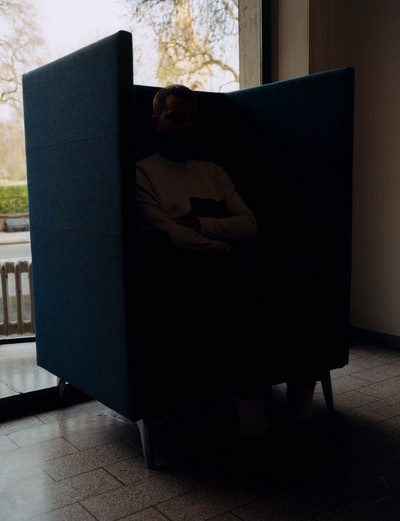
Tell us about your collection.
Sebastian Röck: Since losing my hearing in 2010 my memory of sound is fading more and more every day, making it a somewhat abstract concept. When the surrounding world is quiet, it can be very difficult to feel connected with or even grounded within it, partly because our brain is made to link sound directly to our emotional experiences. My work, Multisensory Bodies, explores ways how one (and I) can experience sound without hearing. In order to achieve this I am developing different experiences that translate sound into other stimuli. The first experience I created is a visual translation of sound: three-dimensional digital sculptures created from sound, based on an algorithm that uses pitch, volume, timbre, and other aspects of noise. While they don’t enable you to understand the sound, they are the first step to reaching a translation of sound’s emotional layer. The second part is a garment that translates sound information into tactile experiences on the body. All previous projects in this field focused on practical aspects like being alert to traffic noises or doorbells, and used vibrating motors to achieve this. While this might be valid, most deaf people don’t really need help to navigate safely through traffic or be alert to their doorbell, we’ve got that covered. In my personal experience and supported by scientific research, the emotional sphere of sound is more important.
What’s the best thing about the Royal College of Art’s MA fashion programme?
Sebastian Röck: The RCA provides us with a space to think beyond our learned truths of what fashion is and what designers are supposed to do. In a world that doesn’t need more of anything, what is the role of the designer? How can we be relevant in a changing environment? Studying here has been a truly transformative experience by encouraging me to think bigger and differently. The tutors and the cohort have helped me to free myself of the restraints and expectations of an industry that is afraid of change.
Which person in fashion do you most admire, and why?
Sebastian Röck: This is a particularly hard question to answer, but I admire the work of Ellen Fowles, whose work has the potential to have a positive impact on the lives of so many people by implementing small, but really intelligent changes that make clothing more inclusive. Another person to mention here is Anne Ferial. I find her work utilizing her experience as a stroke survivor to develop innovative new therapeutic systems truly mind-blowing.
What can younger designers express through fashion that designers from an older generation cannot?
Sebastian Röck: Fashion is an interesting place to be right now. While everyone who is part of it knows that we are at the beginning of fundamental change, the majority of players have decided to ignore that fact. The vanishing boundaries between the physical and digital and the coming of age of new technologies give us the opportunity to facilitate real change and make truly innovative things, although they might not fit the traditional idea of fashion.
Finally, where do you see yourself professionally in five years’ time?
Sebastian Röck: My plan is to continue my research within a PhD programme. The potential of wearable technology for the inclusion of people with disabilities and more broadly, inclusivity in digital worlds has yet to be explored in depth. I hope that my personal experience will be of great value in advancing this.
Weilin Song, 25
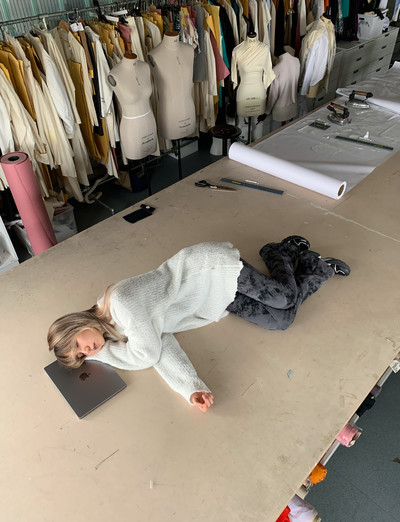
Tell us about your collection.
Weilin Song: Co-Dream is a virtual dreamworld created by computer and human together. Imagine a dreamworld built by your consciousness and the machine; imagine your dreams growing in your body.
What are your stylistic ambitions and references?
Weilin Song: There are no references. If anything, it is this moment in time that allows me to see and hear and think. Everything that runs through my mission guides me to where I am going to arrive.
What do you want to communicate to the world through your collection?
Weilin Song: The purpose of my work is twofold: one is to record dreams, from consciousness to objects, from thinking to seeing. The second is to demonstrate that computers have a new form of cognition, which will have a cultural impact. The relationship between man and machine will move from enslavement to coupling.
Did you have anybody in mind when you envisaged your collection being worn?
Weilin Song: Anyone and any object can wear my work. Co-Dream contains a new machine-vision cognitive system, and each segment of consciousness produces a unique result. The Co-Dream knitting machine is to reconstruct the world with knitting. In its eyes, it’s maybe not humans who should wear the clothes.
What’s the best thing about the Royal College of Art’s MA fashion programme?
Weilin Song: Freedom. The space you’re in, the time you’re given, the people who surround you all contribute to your freedom to explore yourself and the world.
Which person in fashion do you most admire, and why?
Weilin Song: Hussein Chalayan. Always. He’s always there, never losing his curiosity about the future, self-assured and powerful. Like him, technology is something I can’t leave behind. New, tried, experimented: behind all these is time and risk. Being unchanging is the most precious thing, and I hope I’m still dreaming 50 years from now.
What can younger designers express through fashion that designers from an older generation cannot?
Weilin Song: I only represent myself; I don’t represent other young designers. A different generation means that people are exposed to different things at an age when they are keen to experiment, such as the virtual, which can change the way our generation lives and perceives. Co-Dream means that fashion is something that everyone can actively create, rather than passively choose.
Finally, where do you see yourself professionally in five years’ time?
Weilin Song: Virtual directions: the art of interconnecting the human brain with the computer.